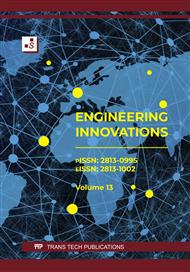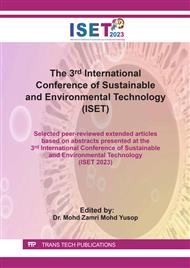[1]
Farkas, A., et al., Opportunistic pathogens and faecal indicators in drinking water associated biofilms in Cluj, Romania. Journal of Water and Health, 2012. 10(3): pp.471-483.
DOI: 10.2166/wh.2012.148
Google Scholar
[2]
Hile, T.D., S.G. Dunbar, and R.G. Sinclair, Microbial contamination analysis of drinking water from bulk dispensers and fast-food restaurants in the Eastern Coachella Valley, California. Water Supply, 2023. 23(9): pp.3578-3596.
DOI: 10.2166/ws.2023.200
Google Scholar
[3]
da Silva, M.E.Z., et al., Comparison of the bacteriological quality of tap water and bottled mineral water. International journal of hygiene and environmental health, 2008. 211(5): pp.504-509.
DOI: 10.1016/j.ijheh.2007.09.004
Google Scholar
[4]
Pichel, N., M. Vivar, and M. Fuentes, The problem of drinking water access: A review of disinfection technologies with an emphasis on solar treatment methods. Chemosphere, 2019. 218: pp.1014-1030.
DOI: 10.1016/j.chemosphere.2018.11.205
Google Scholar
[5]
Al Moosa, M.E., et al., Microbiological Quality of Drinking Water from Water Dispenser Machines. International Journal of Environmental Science and Development, 2015. 6(9): pp.710-713.
Google Scholar
[6]
Alhassan, H. and P.A. Kwakwa, When water is scarce: the perception of water quality and effects on the vulnerable. Journal of Water, Sanitation and Hygiene for Development, 2014. 4(1): pp.43-50.
DOI: 10.2166/washdev.2013.140
Google Scholar
[7]
Mishra, R.K., Fresh water availability and its global challenge. British Journal of Multidisciplinary and Advanced Studies, 2023. 4(3): pp.1-78.
Google Scholar
[8]
Malik, S., P. Khyalia, and J.S. Laura, Conventional methods and materials used for water treatment in rural areas, in Water Resources Management for Rural Development. 2024, Elsevier. pp.79-90.
DOI: 10.1016/b978-0-443-18778-0.00010-6
Google Scholar
[9]
Baquero, F., J.-L. Martínez, and R. Cantón, Antibiotics and antibiotic resistance in water environments. Current opinion in biotechnology, 2008. 19(3): pp.260-265.
DOI: 10.1016/j.copbio.2008.05.006
Google Scholar
[10]
Falcone-Dias, M.F., I. Vaz-Moreira, and C.M. Manaia, Bottled mineral water as a potential source of antibiotic resistant bacteria. Water research, 2012. 46(11): pp.3612-3622.
DOI: 10.1016/j.watres.2012.04.007
Google Scholar
[11]
Zhang, K., et al., Characterization of antibiotic resistance genes in drinking water sources of the Douhe Reservoir, Tangshan, northern China: the correlation with bacterial communities and environmental factors. Environmental Sciences Europe, 2022. 34(1): p.56.
DOI: 10.1186/s12302-022-00635-x
Google Scholar
[12]
Obotey Ezugbe, E. and S. Rathilal, Membrane technologies in wastewater treatment: a review. Membranes, 2020. 10(5): p.89.
DOI: 10.3390/membranes10050089
Google Scholar
[13]
Ali, S.S., Z. Anwar, and J.Z.K. Khattak, Microbial analysis of drinking water and water distribution system in new urban Peshawar. Current Research Journal of Biological Sciences, 2012. 4(6): pp.731-737.
Google Scholar
[14]
Maniam, G., et al., Water literacy in the southeast Asian context: Are we there yet? Water, 2021. 13(16): p.2311.
DOI: 10.3390/w13162311
Google Scholar
[15]
Tan, E.Y., M. Arifullah, and J.M. Soon, Identification of Escherichia coli strains from water vending machines of Kelantan, Malaysia using 16S rRNA gene sequence analysis. Exposure and Health, 2016. 8: pp.211-216.
DOI: 10.1007/s12403-016-0194-x
Google Scholar
[16]
Zhou, S., T. Urase, and S. Goto, Constituents of Coliform Species Contained in the Permeate of Microfiltration Membranes in Wastewater Treatment. Water, 2024. 16(9): p.1269.
DOI: 10.3390/w16091269
Google Scholar
[17]
Bloomfield, S.F., et al. The chain of infection transmission in the home and everyday life settings, and the role of hygiene in reducing the risk of infection. in International scientific forum on home hygiene. 2012.
Google Scholar
[18]
Kumar, S., G. Stecher, and K. Tamura, MEGA7: molecular evolutionary genetics analysis version 7.0 for bigger datasets. Molecular biology and evolution, 2016. 33(7): pp.1870-1874.
DOI: 10.1093/molbev/msw054
Google Scholar
[19]
Boesenberg-Smith, K.A., M.M. Pessarakli, and D.M. Wolk, Assessment of DNA yield and purity: an overlooked detail of PCR troubleshooting. Clinical Microbiology Newsletter, 2012. 34(1): pp.1-6.
DOI: 10.1016/j.clinmicnews.2011.12.002
Google Scholar
[20]
Inayatullah, A. and M. Abdurrahman Munir, DETECTION OF PORCINE IN GELATIN An inspirational book for the halal industry. 2022, Alma Ata University Press (AAUP).
Google Scholar
[21]
Barbosa, C., et al., DNA extraction: finding the most suitable method, in Molecular microbial diagnostic methods. 2016, Elsevier. pp.135-154.
DOI: 10.1016/b978-0-12-416999-9.00007-1
Google Scholar
[22]
Paul, B., Concatenated 16S rRNA sequence analysis improves bacterial taxonomy. F1000Research, 2022. 11.
DOI: 10.12688/f1000research.128320.1
Google Scholar
[23]
Chambers, G.K., et al., DNA fingerprinting in zoology: past, present, future. Investigative genetics, 2014. 5(1): pp.1-11.
Google Scholar
[24]
Kommedal, Ø., B. Karlsen, and Ø. Sæbø, Analysis of mixed sequencing chromatograms and its application in direct 16S rRNA gene sequencing of polymicrobial samples. Journal of Clinical Microbiology, 2008. 46(11): pp.3766-3771.
DOI: 10.1128/jcm.00213-08
Google Scholar
[25]
Al-Shuhaib, M.B.S. and H.O. Hashim, Mastering DNA chromatogram analysis in Sanger sequencing for reliable clinical analysis. Journal of Genetic Engineering and Biotechnology, 2023. 21(1): p.115.
DOI: 10.1186/s43141-023-00587-6
Google Scholar
[26]
Berry, V. and O. Gascuel, Inferring evolutionary trees with strong combinatorial evidence. Theoretical computer science, 2000. 240(2): pp.271-298.
DOI: 10.1016/s0304-3975(99)00235-2
Google Scholar
[27]
Katsura, Y., et al., The reliability and stability of an inferred phylogenetic tree from empirical data. Molecular Biology and Evolution, 2017. 34(3): pp.718-723.
Google Scholar
[28]
Chang, J.-M., et al., Incorporating alignment uncertainty into Felsenstein's phylogenetic bootstrap to improve its reliability. Bioinformatics, 2021. 37(11): pp.1506-1514.
DOI: 10.1093/bioinformatics/btz082
Google Scholar
[29]
Russo, C.A.d.M. and A.P. Selvatti, Bootstrap and rogue identification tests for phylogenetic analyses. Molecular Biology and Evolution, 2018. 35(9): pp.2327-2333.
DOI: 10.1093/molbev/msy118
Google Scholar
[30]
Amann, R.I., W. Ludwig, and K.-H. Schleifer, Phylogenetic identification and in situ detection of individual microbial cells without cultivation. Microbiological reviews, 1995. 59(1): pp.143-169.
DOI: 10.1128/mmbr.59.1.143-169.1995
Google Scholar
[31]
Thompson, C.C., et al., Microbial genomic taxonomy. Trends in the systematics of bacteria and fungi, 2021: pp.168-178.
Google Scholar
[32]
Berman, H., Bacterial Species In the Age of Next-Generation Sequencing, in American Society for Microbiology. 2021: North Carolina State University.
Google Scholar
[33]
Ferraz Helene, L.C., M.S. Klepa, and M. Hungria, New insights into the taxonomy of bacteria in the genomic era and a case study with rhizobia. International Journal of Microbiology, 2022. 2022(1): p.4623713.
DOI: 10.1155/2022/4623713
Google Scholar
[34]
Rodriguez-R, L.M., et al., An ANI gap within bacterial species that advances the definitions of intra-species units. MBio, 2024. 15(1): p. e02696-23.
Google Scholar
[35]
Ludwig, W., et al., Bacterial phylogeny based on comparative sequence analysis. Electrophoresis, 1998. 19(4): pp.554-568.
Google Scholar
[36]
Rodriguez-R, L.M. and K.T. Konstantinidis, Bypassing cultivation to identify bacterial species. Microbe, 2014. 9(3): pp.111-118.
Google Scholar
[37]
Barco, R., et al., A genus definition for bacteria and archaea based on a standard genome relatedness index. MBio, 2020. 11(1): p.10.1128/mbio. 02475-19.
DOI: 10.1128/mbio.02475-19
Google Scholar
[38]
Parija, S.C., Bacillus, in Textbook of Microbiology and Immunology. 2023, Springer. pp.407-418.
Google Scholar
[39]
Jenson, I. and C.J. Moir, Bacillus cereus and other Bacillus species. Foodborne microorganisms of public health significance, 2003(Ed. 6): pp.445-478.
Google Scholar
[40]
Tirloni, E., et al., Bacillus cereus in dairy products and production plants. Foods, 2022. 11(17): p.2572.
DOI: 10.3390/foods11172572
Google Scholar
[41]
Elshafie, S.S., Bacillus Cereus Osteomyelitis in an Athlete: Case Report and Review of the Literature A Case Report. Journal of Clinical Review & Case Reports, 2021. 6(2): pp.585-588.
DOI: 10.33140/jcrc.06.02.02
Google Scholar
[42]
Bottone, E.J., Bacillus cereus, a volatile human pathogen. Clinical microbiology reviews, 2010. 23(2): pp.382-398.
DOI: 10.1128/cmr.00073-09
Google Scholar
[43]
Khongkool, K., et al., Qualitative Analysis of Fibre-Degrading Enzymes Production by Bacillus Isolated from Native Swine Manures. Burapha Science Journal, 2023: pp.647-659.
Google Scholar
[44]
Morabito, S., Developments in improving the safety of sprouts, in Advances in microbial food safety. 2015, Elsevier. pp.351-378.
DOI: 10.1533/9781782421153.3.351
Google Scholar
[45]
Brillard, J., et al., The water cycle, a potential source of the bacterial pathogen Bacillus cereus. BioMed research international, 2015. 2015(1): p.356928.
Google Scholar
[46]
Cai, G., et al., Control for chlorine resistant spore forming bacteria by the coupling of pre-oxidation and coagulation sedimentation, and UV-AOPs enhanced inactivation in drinking water treatment. Water Research, 2022. 219: p.118540.
DOI: 10.1016/j.watres.2022.118540
Google Scholar
[47]
Auger, S., et al., Biofilm formation and cell surface properties among pathogenic and nonpathogenic strains of the Bacillus cereus group. Applied and environmental microbiology, 2009. 75(20): pp.6616-6618.
DOI: 10.1128/aem.00155-09
Google Scholar
[48]
Majed, R., et al., Bacillus cereus biofilms—same, only different. Frontiers in microbiology, 2016. 7: p.1054.
DOI: 10.3389/fmicb.2016.01054
Google Scholar
[49]
Sturmer, F.d.C.R., et al., Detection and characterization of Bacillus cereus isolated from the dialysis fluid. Revista do Instituto de Medicina Tropical de São Paulo, 2022. 64: p. e67.
DOI: 10.1590/s1678-9946202264067
Google Scholar
[50]
Østensvik, Ø., et al., Cytotoxic Bacillus spp. belonging to the B. cereus and B. subtilis groups in Norwegian surface waters. Journal of applied microbiology, 2004. 96(5): pp.987-993.
DOI: 10.1111/j.1365-2672.2004.02226.x
Google Scholar
[51]
Bezuidenhout, C.C., et al., Draft genome sequences of two Bacillus bombysepticus strains from drinking Water. Microbiology Resource Announcements, 2023. 12(7): p. e00434-23.
DOI: 10.1128/mra.00434-23
Google Scholar
[52]
Hazards, E.Panel o.B., Risks for public health related to the presence of Bacillus cereus and other Bacillus spp. including Bacillus thuringiensis in foodstuffs. EFSA Journal, 2016. 14(7): p. e04524.
DOI: 10.2903/j.efsa.2016.4524
Google Scholar
[53]
Virgianti, D.P., D. Natalia, and I.N.P. Aryantha, New record of Stenotrophomonas sp. as endosymbiont bacteria in Rhizopus microsporus. Biodiversitas Journal of Biological Diversity, 2020. 21(4).
DOI: 10.13057/biodiv/d210449
Google Scholar
[54]
Erdei-Tombor, P., G. Kiskó, and A. Taczman-Brückner, Biofilm Formation in Water Distribution Systems. Processes, 2024. 12(2): p.280.
DOI: 10.3390/pr12020280
Google Scholar
[55]
Urase, T., X. Yang, and S. Goto, Occurrence of Stenotrophomonas spp. in the Water Environment and Characteristics of Isolates. Journal of Water and Environment Technology, 2023. 21(4): pp.213-223.
DOI: 10.2965/jwet.22-153
Google Scholar
[56]
Kenzaka, T. and K. Tani, Draft genome sequence of multidrug-resistant Stenotrophomonas pavanii BWK1, isolated from Mareca penelope feces. Genome Announcements, 2018. 6(12): p.10.1128/genomea. 00187-18.
DOI: 10.1128/genomea.00187-18
Google Scholar
[57]
Ansahrullah, K.N. and F.A. Shafie, Water quality of water vending machines in Gombak, Selangor. MAEH Journal of Environmental Health, 2021. 3(2): pp.1-6.
Google Scholar
[58]
Muhammad, M.S., et al., Microbiological analysis of drinking water from water vending machines. Malaysian Journal of Fundamental and Applied Sciences, 2020. 16(2): pp.186-189.
DOI: 10.11113/mjfas.v16n2.1486
Google Scholar
[59]
Hamid, T.H.T.A., A.A.A. Hamid, and N.H. Padzil, Isolation of moderately halophilic lipase producing bacteria from sponges in pahang coastal water, malaysia. Jurnal Teknologi, 2015. 77(25).
DOI: 10.11113/jt.v77.6740
Google Scholar
[60]
Aldahi, A., STUDIES ON MICROBES INCLUDING POTENTIAL HUMAN PATHOGENS FROM INSECTS AND OTHER INVERTEBRATES. 2017, University of Sheffield.
Google Scholar
[61]
Looney, W.J., M. Narita, and K. Mühlemann, Stenotrophomonas maltophilia: an emerging opportunist human pathogen. The Lancet infectious diseases, 2009. 9(5): pp.312-323.
DOI: 10.1016/s1473-3099(09)70083-0
Google Scholar
[62]
Mahdi, O., B. Eklund, and N. Fisher, Stenotrophomonas maltophilia: laboratory culture and maintenance. Current protocols in microbiology, 2014. 32: p. Unit.
DOI: 10.1002/9780471729259.mc06f01s32
Google Scholar
[63]
Ryan, R.P., et al., The versatility and adaptation of bacteria from the genus Stenotrophomonas. Nature reviews microbiology, 2009. 7(7): pp.514-525.
Google Scholar
[64]
Brooke, J.S., New strategies against Stenotrophomonas maltophilia: a serious worldwide intrinsically drug-resistant opportunistic pathogen. 2014, Taylor & Francis. pp.1-4.
DOI: 10.1586/14787210.2014.864553
Google Scholar
[65]
Brooke, J.S., Advances in the microbiology of Stenotrophomonas maltophilia. Clinical microbiology reviews, 2021. 34(3): p.10.1128/cmr. 00030-19.
Google Scholar
[66]
Pathmanathan, A. and G. Waterer, Significance of positive Stenotrophomonas maltophilia culture in acute respiratory tract infection. European Respiratory Journal, 2005. 25(5): pp.911-914.
DOI: 10.1183/09031936.05.00096704
Google Scholar
[67]
Harmon, D.E., et al., Prevalence and characterization of carbapenem‐resistant bacteria in water bodies in the Los Angeles–Southern California area. Microbiologyopen, 2019. 8(4): p. e00692.
DOI: 10.1002/mbo3.692
Google Scholar
[68]
WILKINSON and KERR, Bottled water as a source of multi‐resistant Stenotrophomonas and Pseudomonas species for neutropenic patients. European journal of cancer care, 1998. 7(1): pp.12-14.
DOI: 10.1046/j.1365-2354.1998.00059.x
Google Scholar
[69]
Brooke, J.S., Stenotrophomonas maltophilia: an emerging global opportunistic pathogen. Clinical microbiology reviews, 2012. 25(1): pp.2-41.
DOI: 10.1128/cmr.00019-11
Google Scholar
[70]
Mojica, M.F., et al., Clinical challenges treating Stenotrophomonas maltophilia infections: an update. JAC-antimicrobial Resistance, 2022. 4(3): p. dlac040.
Google Scholar
[71]
Said, M.S., E. Tirthani, and E. Lesho, Stenotrophomonas maltophilia. 2021.
Google Scholar
[72]
Nazik, M., et al., Diversity and antibiotic susceptibilities of bacterial species from surfaces of publicly used equipment in a medical education setting. African Journal of Microbiology Research, 2015. 9(45): pp.2239-2248.
DOI: 10.5897/ajmr2015.7648
Google Scholar
[73]
Chaidez, C., et al., Microbiological quality of water vending machines. International Journal of Environmental Health Research, 1999. 9(3): pp.197-206.
DOI: 10.1080/09603129973164
Google Scholar
[74]
Al Moosa, M.E., et al., Microbiological quality of drinking water from water dispenser machines. International Journal of Environmental Science and Development, 2015. 6(9): p.710.
Google Scholar



